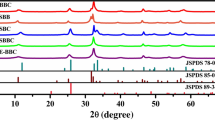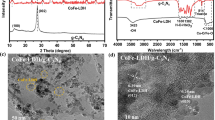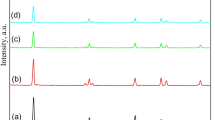Abstract
A series of Z-scheme β-Bi2O3/ZrO2 heterojunction composites containing three-dimensional (3D) mesoporous silica nanospheres (MSNs) were synthesized as efficient catalysts for antibiotic remediation. The obtained MSN/β-Bi2O3/ZrO2 ternary composites possess novel lamellar cross structure, which is well constructed by β-Bi2O3 nanosheets, 3D MSNs, and ZrO2 nanoparticles. The optimal sample BZS-2 (Bi: Zr: Si = 1: 0.4: 0.33) shows an adsorptive-photocatalytic removal efficiency of 92.7% towards levofloxacin (LVF) and a total organic carbon (TOC) removal efficiency of 60.0% under simulated solar light irradiation for 100 min. BZS-2 can also remove 90.1% and 91.2% of tetracycline hydrochloride (TC) and oxytetracycline hydrochloride (OTC), respectively, and the maximum adsorption capacity of TC over BZS-2 is almost 10 times that of β-Bi2O3. The improvement of photocatalytic activity can be mainly attributed to the enhanced visible-light adsorption capacity and more efficient separation of photogenerated electron–hole pairs. A possible Z-scheme photocatalytic mechanism of β-Bi2O3/ZrO2 heterojunctions based on valence band offset (ΔEVBO) and conduction band offset (ΔECBO) is proposed. This study provides an efficient way to construct novel mesoporous ternary photocatalyst with increased accessible surface area and active sites for treatment of antibiotics by synergistic adsorption and photocatalysis.
Graphical abstract

摘要
本文合成了一系列Z型β-Bi2O3/ZrO2异质结和3D介孔二氧化硅纳米球(MSNs)的复合光催化剂, 用于高效去除废水中的抗生素. 所合成的MSN/β-Bi2O3/ZrO2三元复合材料由β-Bi2O3纳米片, 3D MSNs和ZrO2纳米颗粒组成, 具有新颖的层状交叉结构. 在模拟太阳光照射100 min时, 最优化样品BZS-2 (Bi: Zr: Si 摩尔比为 1: 0.4:0.33)对废水中左氧氟沙星(LVF)的吸附-光催化协同去除率为92.7%, 并且对TOC的去除率可达60%。 BZS-2对盐酸四环素(TC)和盐酸土霉素(OTC)的去除率分别为90.1%和91.2%, 其对TC的最大吸附量几乎是β-Bi2O3的10倍。 光催化活性的提高主要是由于可见光吸附吸收能力的增强和光致电子-空穴对分离效率的提高。 基于价带偏移(ΔEVBO)和导带偏移(ΔECBO), 提出了Z型β-Bi2O3/ZrO2异质结光催化机理。本研究为构建具有较大的比表面积和较高活性的新型介孔三元光催化剂提供了一种有效的途径, 所制备的催化剂可用于吸附-光催化协同高效处理抗生素废水。










Similar content being viewed by others
References
Li D, Shi W. Recent developments in visible-light photocatalytic degradation of antibiotics. Chin J Catal. 2016;37(6):792.
Rodriguez-Mozaz S, Chamorro S, Marti E, Huerta B, Gros M, Sanchez-Melsio A, Borrego CM, Barcelo D, Balcazar JL. Occurrence of antibiotics and antibiotic resistance genes in hospital and urban wastewaters and their impact on the receiving river. Water Res. 2015;69:234.
Danner MC, Robertson A, Behrends V, Reiss J. Antibiotic pollution in surface fresh waters: occurrence and effects. Sci Total Environ. 2019;664:793.
Xu X, Deng F, Shao P, Dionysiou DD, Luo X, Li X, Zhang S, Liu X, Liu M. Internal electric field driving separation and migration of charge carriers via Z-scheme path in AgIn5S8/ZnO heterojunction for efficient decontamination of pharmaceutical pollutants. Chem Eng J. 2022;428:132096.
Huang S, Ouyang T, Zheng BF, Dan M, Liu ZQ. Enhanced photoelectrocatalytic activities for CH3OH to HCHO conversion on Fe2O3/MoO3: Fe-O-Mo covalency dominates the intrinsic activity. Angew Chem Int Ed. 2021;60(17):9546.
Cheng Q, Zhang GK. Enhanced photocatalytic performance of tungsten-based photocatalysts for degradation of volatile organic compounds – a review. Tungsten. 2020;2(3):240.
Yu Y, Xu W, Fang J, Chen D, Pan T, Feng W, Liang Y, Fang Z. Soft-template assisted construction of superstructure TiO2/SiO2/g-C3N4 hybrid as efficient visible-light photocatalysts to degrade berberine in seawater via an adsorption-photocatalysis synergy and mechanism insight. Appl Catal B: Environ. 2020;268:118751.
Goud BS, Koyyada G, Jung JH, Reddy GR, Shim J, Nam ND, Vattikuti SVP. Surface oxygen vacancy facilitated Z-scheme MoS2/Bi2O3 heterojunction for enhanced visible-light driven photocatalysis-pollutant degradation and hydrogen production. Int J Hydrogen Energ. 2020;45(38):18961.
Huang S, Zheng BF, Tang ZY, Mai XQ, Ouyang T, Liu ZQ. CH3OH selective oxidation to HCHO on Z-scheme Fe2O3/g-C3N4 hybrid: the rate-determining step of C-H bond scission. Chem Eng J. 2021;422:130086.
Li L, Zheng X, Chi Y, Wang Y, Sun X, Yue Q, Gao B, Xu S. Molecularly imprinted carbon nanosheets supported TiO2: strong selectivity and synergic adsorption-photocatalysis for antibiotics removal. J Hazard Mater. 2020;383:121211.
Zhou Q, Huang W, Xu C, Liu X, Yang K, Li D, Hou Y, Dionysiou DD. Novel hierarchical carbon quantum dots-decorated BiOCl nanosheet/carbonized eggshell membrane composites for improved removal of organic contaminants from water via synergistic adsorption and photocatalysis. Chem Eng J. 2021;420(1):129582.
Bai X, Wang Y, Li Y, Wang X. Adsorption–photocatalytical remediation for series of tetracycline contaminants with BiOCl–CdS composite under simulated sunlight. J Taiwan Inst Chem E. 2019;104:94.
Chen Z, Huang C, Zhou T, Hu J. Strike a balance between adsorption and catalysis capabilities in Bi2Se3−xOx composites for high-efficiency antibiotics remediation. Chem Eng J. 2020;382:122877.
Sacco O, Vaiano V, Matarangolo M. ZnO supported on zeolite pellets as efficient catalytic system for the removal of caffeine by adsorption and photocatalysis. Sep Purif Technol. 2018;193:303.
Yao H, Pei J, Wang H, Fu J. Effect of Fe(II/III) on tetracycline degradation under UV/VUV irradiation. Chem Eng J. 2017;308:193.
Ouyang Z, Yang C, Lu G, Yao Q, He J, Wang H, Zhang Z, Yang J, Liu Y, Jiang Y, Deng Y, Dang Z. Chromate(VI)-induced homogeneous oxidation and photolysis of aqueous tetracycline: kinetics and mechanism. Chem Eng J. 2020;379:122276.
Reddy CV, Reddy IN, Reddy KR, Jaesool S, Yoo K. Template-free synthesis of tetragonal Co-doped ZrO2 nanoparticles for applications in electrochemical energy storage and water treatment. Electrochim Acta. 2019;317:416.
Wang CC, Xu Q, Wang L, Zhan WC, Yang GL, Guo Y. Effect of metal modification on NH3-SCR reaction performance of Cu-SAPO-34 catalyst. Chin J Rare Met. 2020;44(2):166.
Vignesh K, Priyanka R, Rajarajan M, Suganthi A. Photoreduction of Cr(VI) in water using Bi2O3–ZrO2 nanocomposite under visible light irradiation. Mater Sci Eng B. 2013;178(2):149.
Nanda B, Pradhan AC, Parida KM. Fabrication of mesoporous CuO/ZrO2-MCM-41 nanocomposites for photocatalytic reduction of Cr(VI). Chem Eng J. 2017;316:1122.
Cheng Q, Yang W, Chen Q, Zhu J, Li D, Fu L, Zhou L. Fe-doped zirconia nanoparticles with highly negative conduction band potential for enhancing visible light photocatalytic performance. Appl Surf Sci. 2020;530:147291.
Li Q, Chen C, Li C, Liu R, Bi S, Zhang P, Zhou Y, Mai Y. Ordered bicontinuous mesoporous polymeric semiconductor photocatalyst. ACS Nano. 2020;14(10):13652.
Aziz FFA, Jalil AA, Hassan NS, Hitam CNC, Rahman AFA, Fauzi AA. Enhanced visible-light driven multi-photoredox Cr(VI) and p-cresol by Si and Zr interplay in fibrous silica-zirconia. J Hazard Mater. 2021;401:123277.
Wang Y, Du X, Liu Z, Shi S, Lv H. Dendritic fibrous nano-particles (DFNPs): rising stars of mesoporous materials. J Mater Chem A. 2019;7(10):5111.
Lu H, Hao Q, Chen T, Zhang L, Chen D, Ma C, Yao W, Zhu Y. A high-performance Bi2O3/Bi2SiO5 p-n heterojunction photocatalyst induced by phase transition of Bi2O3. Appl Catal B Environ. 2018;237:59.
Wang D, Yu X, Feng Q, Lin X, Huang Y, Huang X, Li X, Chen K, Zhao B, Zhang Z. In-situ growth of β-Bi2O3 nanosheets on g-C3N4 to construct direct Z-scheme heterojunction with enhanced photocatalytic activities. J Alloy Compd. 2021;859:157795.
Yang X, Zhang Y, Wang Y, Xin C, Zhang P, Liu D, Mamba BB, Kefeni KK, Kuvarega AT, Gui J. Hollow β-Bi2O3@CeO2 heterostructure microsphere with controllable crystal phase for efficient photocatalysis. Chem Eng J. 2020;387:124100.
Žerjav G, Teržan J, Djinović P, Barbieriková Z, Hajdu T, Brezová V, Zavašnik J, Kovač J, Pintar A. TiO2-β-Bi2O3 junction as a leverage for the visible-light activity of TiO2 based catalyst used for environmental applications. Cataly Today. 2021;361:165.
Zhang X, Li L, Wen S, Luo H, Yang C. Design and synthesis of multistructured three-dimensionally ordered macroporous composite bismuth oxide/zirconia: photocatalytic degradation and hydrogen production. J Colloid Interface Sci. 2017;499:159.
Fu F, Shen H, Xue W, Zhen Y, Soomro RA, Yang X, Wang D, Xu B, Chi R. Alkali-assisted synthesis of direct Z-scheme based Bi2O3/Bi2MoO6 photocatalyst for highly efficient photocatalytic degradation of phenol and hydrogen evolution reaction. J Catal. 2019;375:399.
Liu X, Yang Z, Zhang L. In-situ fabrication of 3D hierarchical flower-like beta-Bi2O3@CoO Z-scheme heterojunction for visible-driven simultaneous degradation of multi-pollutants. J Hazard Mater. 2021;403:123566.
He S, Yan C, Chen XZ, Wang Z, Ouyang T, Guo ML, Liu ZQ. Construction of core-shell heterojunction regulating Fe2O3 layer on CeO2 nanotube arrays enables highly efficient Z-scheme photoelectrocatalysis. Appl Catal B Environ. 2020;276:119138.
Wang Y, Song H, Yu M, Xu C, Liu Y, Tang J, Yang Y, Yu C. Room temperature synthesis of dendritic mesoporous silica nanoparticles with small sizes and enhanced mRNA delivery performance. J Mater Chem B. 2018;6(24):4089.
Fang X, Chen J, Zhan J. Heterojunction photocatalyst for organic degradation: superior photocatalytic activity through the phase and interface engineering. Ceram Int. 2020;46(14):23245.
Munguti L, Dejene F. Effects of Zn: Ti molar ratios on the morphological, optical and photocatalytic properties of ZnO-TiO2 nanocomposites for application in dye removal. Mat Sci Semicon Proc. 2021;128:105786.
Janani B, Syed A, Thomas AM, Al-Rashed S, Raju LL, Khan SS. Designing spinel NiCr2O4 loaded Bi2O3 semiconductor hybrid for mitigating the charge recombination and tuned band gap for enhanced white light photocatalysis and antibacterial applications. J Alloy Compd. 2021;865:158735.
Reddy CV, Reddy IN, Harish VVN, Reddy KR, Shetti NP, Shim J, Aminabhavi TM. Efficient removal of toxic organic dyes and photoelectrochemical properties of iron-doped zirconia nanoparticles. Chemosphere. 2020;239:124766.
Zhang L, Wang G, Xiong Z, Tang H, Jiang C. Fabrication of flower-like direct Z-scheme β-Bi2O3/g-C3N4 photocatalyst with enhanced visible light photoactivity for Rhodamine B degradation. Appl Surf Sci. 2018;436:162.
Zhao J, Otgonbayar Z, Fatema KN, Sagadevan S, Oh WC. Novel-structured mesoporous SiO2 and ZrO2–GO nanocomposite for photocatalytic degradation of toxic phenolic derivatives under the visible light irradiation. Surf Interface. 2020;20:100613.
Ferraz NP, Nogueira AE, Marcos FCF, Machado VA, Rocca RR, Assaf EM, Asencios YJO. CeO2–Nb2O5 photocatalysts for degradation of organic pollutants in water. Rare Met. 2020;39(3):230.
de Moraes NP, da Silva RR, da Silva MLCP, Campos TMB, Thim GP, Landers R, Rodrigues LA. Facile preparation of Bi-doped ZnO/β-Bi2O3/Carbon xerogel composites towards visible-light photocatalytic applications: effect of calcination temperature and bismuth content. Ceram Int. 2020;46(15):23895.
Xin Z, Zhao X, Ji H, Ma T, Li H, Zhong S, Shen Z. Amorphous carbon-linked TiO2/carbon nanotube film composite with enhanced photocatalytic performance: the effect of interface contact and hydrophilicity. Chin Chem Lett. 2020;32(7):2151.
Siwińska-Ciesielczyk K, Świgoń D, Rychtowski P, Moszyński D, Zgoła-Grześkowiak A, Jesionowski T. The performance of multicomponent oxide systems based on TiO2, ZrO2 and SiO2 in the photocatalytic degradation of Rhodamine B: mechanism and kinetic studies. Colloid Surface A. 2020;586:12427.
Mao L, Cai XY, Zhu MS. Hierarchically 1D CdS decorated on 2D perovskite-type La2Ti2O7 nanosheet hybrids with enhanced photocatalytic performance. Rare Met. 2020;40(5):1067.
Vattikuti SVP, Police AKR, Shim J, Byon C. In situ fabrication of the Bi2O3–V2O5 hybrid embedded with graphitic carbon nitride nanosheets: oxygen vacancies mediated enhanced visible-light–driven photocatalytic degradation of organic pollutants and hydrogen evolution. Appl Surf Sci. 2018;447:740.
Hu X, Deng F, Huang W, Zeng G, Luo X, Dionysiou DD. The band structure control of visible-light-driven rGO/ZnS-MoS2 for excellent photocatalytic degradation performance and long-term stability. Chem Eng J. 2018;350:248.
Liu X, Huang WY, Zhou Q, Chen X, Yang K, Li D, Dionysiou DD. Ag-decorated 3D flower-like Bi2MoO6/rGO with boosted photocatalytic performance for removal of organic pollutants. Rare Met. 2020;40(5):1086.
Reddy CV, Neelakanta Reddy I, Ravindranadh K, Raghava Reddy K, Kim D, Shim J. Ni-dopant concentration effect of ZrO2 photocatalyst on photoelectrochemical water splitting and efficient removal of toxic organic pollutants. Sep Purif Technol. 2020;252:117352.
Zhang Y, Yu H, Li S, Wang L, Huang F, Guan R, Li J, Jiao Y, Sun J. Rapidly degradation of di-(2-ethylhexyl) phthalate by Z-scheme Bi2O3/TiO2@reduced graphene oxide driven by simulated solar radiation. Chemosphere. 2021;272:129631.
Huang WY, Wang SH, Zhou Q, Liu X, Chen XR, Yang K, Yu CL, Li D. Constructing novel ternary composites of carbon quantum dots/Bi2MoO6/graphitic nanofibers with tunable band structure and boosted photocatalytic activity. Sep Purif Technol. 2019;217:195.
Yang Y, Wu Z, Yang R, Li Y, Liu X, Zhang L, Yu B. Insights into the mechanism of enhanced photocatalytic dye degradation and antibacterial activity over ternary ZnO/ZnSe/MoSe2 photocatalysts under visible light irradiation. Appl Surf Sci. 2021;539:148220.
Tun PP, Wang J, Khaing TT, Wu X, Zhang G. Fabrication of functionalized plasmonic Ag loaded Bi2O3/montmorillonite nanocomposites for efficient photocatalytic removal of antibiotics and organic dyes. J Alloys Compd. 2020;818:152836.
Liang M, Zou C, Wang W, Yang Z, Yang SJN. Bi metal/oxygen-deficient BiO2-x with tetrahedral morphology and high photocatalytic activity. Nanotechnology. 2020;32(6):065702.
Xia B, Deng F, Zhang S, Hua L, Luo X, Ao M. Design and synthesis of robust Z-scheme ZnS-SnS2 n-n heterojunctions for highly efficient degradation of pharmaceutical pollutants: performance, valence/conduction band offset photocatalytic mechanisms and toxicity evaluation. J Hazard Mater. 2020;392:122345.
Wen XJ, Niu CG, Zhang L, Liang C, Zeng GM. An in depth mechanism insight of the degradation of multiple refractory pollutants via a novel SrTiO3/BiOI heterojunction photocatalysts. J Catal. 2017;356:283.
Acknowledgments
This work was financially supported by National Natural Science Foundation of China (Nos. 21962006, 21607064 and 21707055), the Youth Key Project of Natural Science Foundation of Jiangxi Province (Nos. 20192ACBL20014 and 20192ACBL21011), the Natural Science Foundation of Jiangxi Province (Nos. 20181BAB203018 and 20181BAB213010) and Qingjiang Excellent Young Talents of Jiangxi University of Science and Technology.
Author information
Authors and Affiliations
Corresponding authors
Ethics declarations
Conflict of interests
The authors declare that they have no conflict of interest.
Supplementary Information
Below is the link to the electronic supplementary material.
Rights and permissions
About this article
Cite this article
Xu, C., Zhou, Q., Huang, WY. et al. Constructing Z-scheme β-Bi2O3/ZrO2 heterojunctions with 3D mesoporous SiO2 nanospheres for efficient antibiotic remediation via synergistic adsorption and photocatalysis. Rare Met. 41, 2094–2107 (2022). https://doi.org/10.1007/s12598-021-01897-9
Received:
Revised:
Accepted:
Published:
Issue Date:
DOI: https://doi.org/10.1007/s12598-021-01897-9




